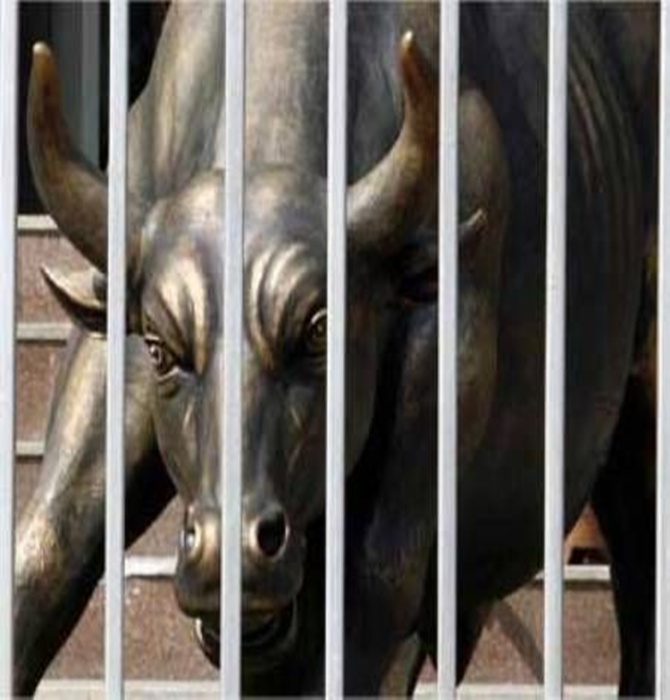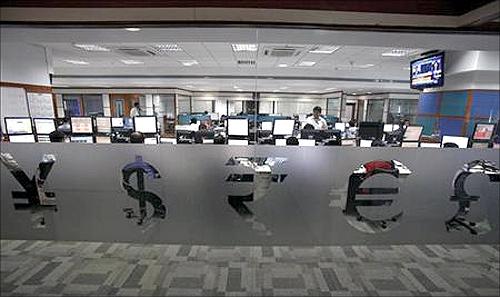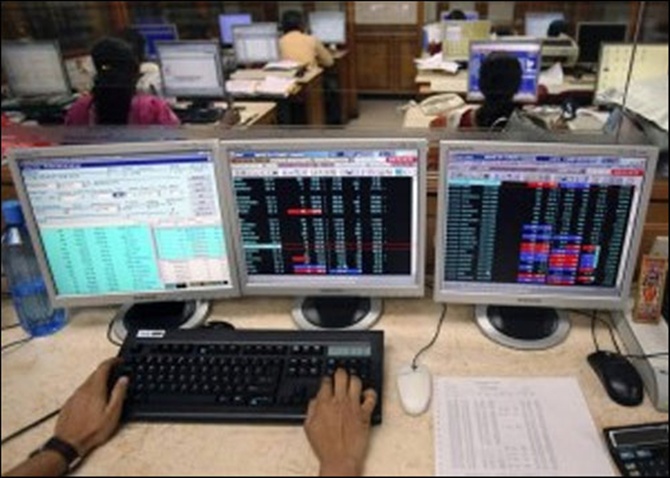Photographs: Reuters Puneet Wadhwa in New Delhi
There is a general meeting of minds among observers on the difficulty of positive factors breaking through.
The markets have been experiencing severe mood swings. Peppered with bouts of recovery and sharp falls, it has been more or less a one-way street for Indian equity markets since mid-May, with the benchmark S&P BSE Sensex and the CNX Nifty dropping 11.3 per cent and 14.6 per cent till date from their recent highs of 20,286 and 6,187, respectively.
Fear about the US Federal Reserve’s tapering of its asset purchase programme amid a sliding rupee (against the dollar), which could worsen India’s macro economic situation, has taken the sheen off markets and severely dented investor confidence.
Of late, the sentiment has also been impacted by flaring crude oil prices, at $117-a-barrel (Brent) on Wednesday with the unrest in Syria. America and its allies were gearing for possible military action against President Bashar al-Assad’s forces, blamed for last week’s chemical weapon attacks on civilians.
What do all these developments mean for the equity markets? After liquidity and greed drove the markets to uncharted levels, is it fear psychosis without a rational look at the fundamentals driving it down?
...
Brace for more market volatility and downside
Photographs: Reuters
US Fed
Meetings of the US central bank’s Federal Open Market Committee show an extraordinary amount of uncertainty about economic data.
This has also led to a wide range of views about the strength of the recovery in the US. “One faction might prefer to wait until the October or December meeting to start tapering, while the other faction is ready to taper in September. An acceptable compromise would be to split the difference,” said Philip Marey, senior US strategist at Rabobank Financial Markets Research.
“This amount of tapering should also have limited impact on the markets, which have been pricing in a September tapering for some time. The market impact could further be reduced by (Fed chief) Bernanke stressing the symmetric flexibility of further tapering at his post-meeting press conference.”
...
Brace for more market volatility and downside
Photographs: Reuters
Volatility ahead
A report from Standard & Poor’s Ratings Services suggests the financial markets appear to be in the midst of pricing in a different path for US monetary policy. During that process, there will be bouts of volatility in emerging Asian economies, along with weaker currencies, lower asset prices, and subdued sentiment and growth.
“The road may be rocky in the near term, particularly for the largest deficit countries – India and Indonesia – but we don't think this is the Asian crisis (of 1997) all over again,” said Standard & Poor's Asia-Pacific Chief Economist Paul Gruenwald.
...
Brace for more market volatility and downside
Photographs: Reuters
Currency woes
It is purely the fear of sharp outflow of funds from both the equity and debt market that has led to a rise in yields and further depreciation of currency, analysts say. With the rupee now sliding to 68.7 against the dollar, they suggest thehe government and the Reserve Bank of India have little ammunition left to address the short-term movement, unless some of the long-term structural problems are addressed.
“The risk of downgrade from rating agencies has increased. FIIs (foreign institutional investors) might remain on the sidelines till the elections, creating a potential funding gap in the balance of payment account,” said G Chokkalingam, chief investment officer, Centrum Wealth Management.
“Owing to uncertainties anticipated during the next six months, we expect the year 2013 to be a lost year for investors. We expect the Sensex at 18,000-19,000 for the rest of 2013, with only a handful of stocks participating in any possible marginal recovery in the broader indices.”
Says Richard Iley, chief Asia economist, BNP Paribas: “Downward pressure on asset prices is unlikely to abate until the rupee becomes decisively cheap (maybe above 70 to the dollar) or the authorities deliver ‘shock and awe’ tightening. With growth expectations likely not yet marked to market adequately, growth-sensitive equity flows, which are key to financing the balance of payments, are at clear risk of reversing.”
...
Brace for more market volatility and downside
Photographs: Reuters
Markets stage slight recovery
After falling nearly three per cent in intra-day trade to touch 17,448.71 (S&P BSE Sensex) and 5,118.85 (CNX Nifty) on the back of a sliding rupee that hit an all-time low of 68.80 to a dollar, the markets regained lost ground on the back of buying in information technology (IT), pharmaceutical, metal and select automobile counters.
Life Insurance Corporation (LIC) was also spotted buying, which allowed India's main indexes to cut losses, reports suggest.
The 30-share Sensex gained 28.07 points or 0.26 per cent to close at 17,996.15 and the 50-share Nifty dropped 2.45 points or 0.05 per cent to 5,285. Says Shrikant Chouhan, head of technical research at Kotak Securities: “Adding long positions at current levels is not advisable with a trading point of view. On the higher side, 5,500 will act as a major resistance in the near term and a close below 5,050 will invite further worries.”






article